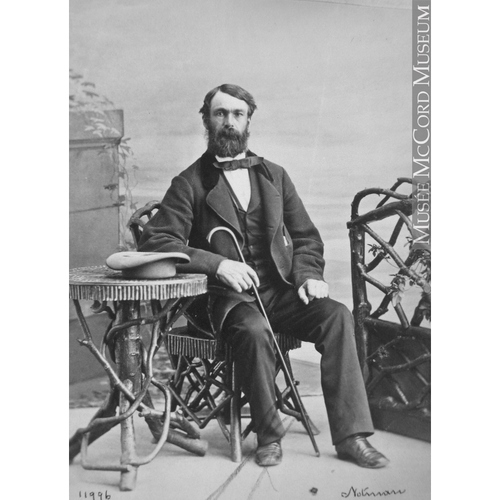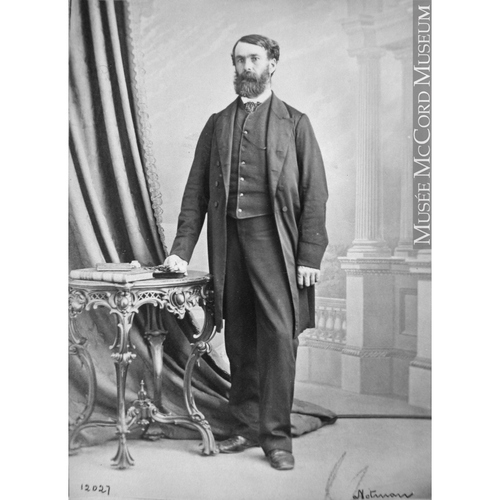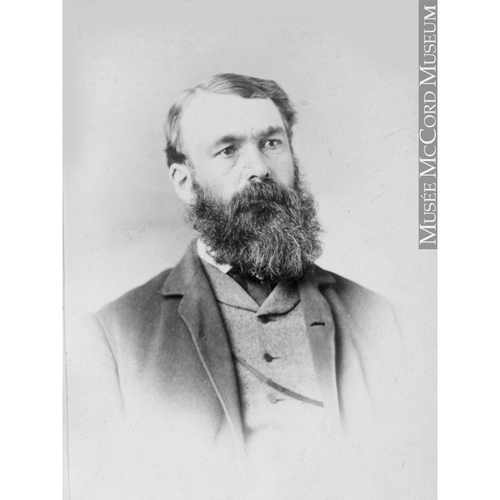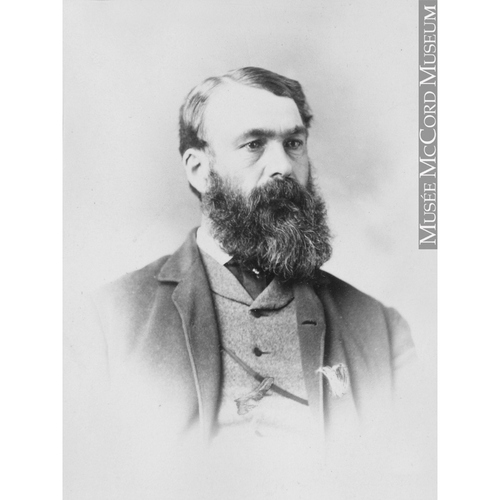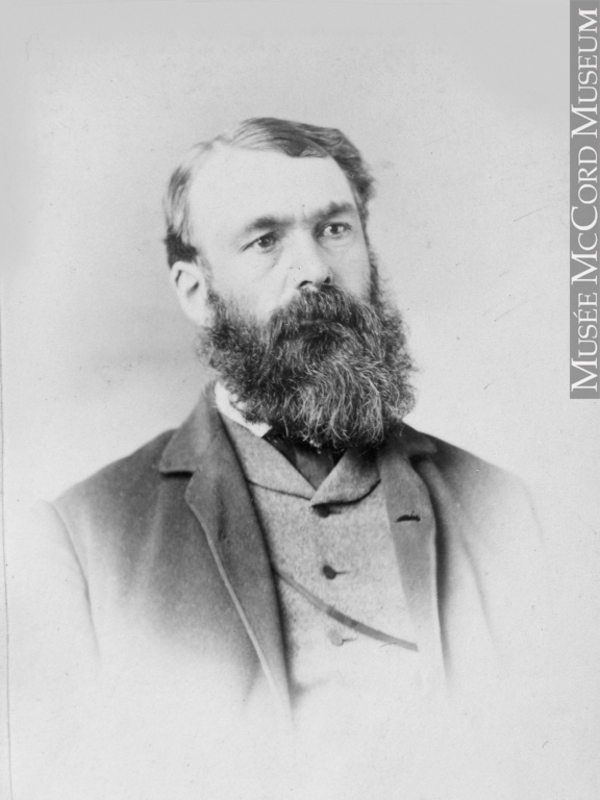
Source: Link
CROIL, JAMES, farmer, church agent, author, historian, and journal editor; b. 4 Sept. 1821 in Glasgow, son of James Croil and — Richardson; m. 8 June 1847, in Halifax, Christina Elizabeth Richardson, sister of the wife of his elder brother William Richardson Croil, and they had five children, two of whom predeceased him; d. 28 Nov. 1916 in Montreal.
The third son of ten children born to a wealthy merchant trading to the West Indies, James Croil received his early education in Glasgow, Edinburgh, and Sunderland, County Durham. He attended the University of Glasgow in 1838–39, and worked briefly in a Glasgow mercantile business before being apprenticed to his uncle in East Lothian to learn farming. He spent much of his time in East Lothian at carpentry and blacksmithing.
In the summer of 1841 he joined his brother William Richardson, who was farming on Stacey (Croil) Island, N.Y., in the St Lawrence River. After two years there James returned to Scotland to buy a farm, but he failed to find suitable property and rejoined William in 1844. In 1845 he purchased the farm of John Crysler* in Upper Canada, site of the battle of 1813 [see Joseph Wanton Morrison*]. Since it was leased for two years, he settled on it only in 1847; in the meantime he travelled through the Ohio and Mississippi valleys. After taking up his property, he was ordained in 1847 an elder of the Presbyterian Church of Canada in connection with the Church of Scotland and married Christina Elizabeth Richardson, daughter of Matthew Richardson of Halifax, who may have been his mother’s uncle. From his own family he had probably inherited considerable wealth, since he paid $6,000 in cash for the 500-acre property. In 1855 he built a new residence, designed by architect George Browne*, and in his own words had “a mansion fit for a duke to live in! It was soon surrounded with plantations, orchards, gardens and shrubbery to match.” He made many of his farm tools, but admitted that he was not a “practical farmer.” That year he leased the land and turned to other interests, including the making of furniture for his home.
Croil had shown neither aptitude nor physical strength for farming, but he was rejuvenated by a sea voyage in 1857. In 1860, when the Presbyterian Church’s Temporalities Fund [see William Snodgrass*] faced a financial shortage, he joined a fund-raising tour; he repeated the experience the following year. The tours raised a total of almost $30,000. Five years later, when the fund again needed money, Croil became the financial agent of his church in the Canadas, and he subsequently travelled over 12,000 miles visiting 126 congregations in 16 months. Between 1865 and 1874, $120,000 was collected for the Temporalities, Home Mission, and Sustentation funds. The report he published of his travels in 1865 is still a valuable source for the history of the church.
Because of his administrative abilities Croil was appointed in 1867 secretary-treasurer of the board which managed the Temporalities Fund’s assets of $450,000. He moved to Montreal in 1869, sold his farm the following year, and became further involved in church affairs. For seven years he was superintendent of the Sunday school at St Paul’s Church and president of Montreal’s Sabbath School Association. Beginning in 1870 Croil published in the Presbyterian, the monthly organ of the church, a continuing account of the discussions concerning union of the four Presbyterian churches in Canada. William Snodgrass, principal of Queen’s College in Kingston, Ont., asserted that the church was indebted to Croil “perhaps more than to any single individual” for the successful completion of negotiations in 1875.
In October 1872 he had been appointed to succeed Douglas Brymner* as editor of the Presbyterian. After the merger of the magazines of the four uniting churches, he was made managing editor of the new periodical, the Presbyterian Record, in 1876. When he resigned the editorship 16 years later, the Record had a circulation of 46,000, larger than that of any other denominational publication in Canada.
In 1873 Croil had become secretary and in 1876 treasurer of the Ministers’ Widows’ and Orphans’ Fund, succeeding his late brother William Richardson, but he resigned these offices when he retired from the Presbyterian Record. As a result of his executive ability and business sense, he was appointed a vice-president of the Dominion Commercial Travellers’ Association and an agent of the Scottish Provident Institution (a mutual life insurance company), and he briefly served as a director of the Consolidated Bank of Canada.
Croil enjoyed travel and his church duties often took him abroad. He was a delegate to meetings of the Church of Scotland in 1875, the Free Church of Scotland in 1879, and the Presbyterian Church, U.S.A., and the United Presbyterian Church of North America in 1876; to the Alliance of Reformed Churches holding the Presbyterian System when it met in Edinburgh, 1877, Philadelphia, 1880, Belfast, 1884, and Washington, 1899; to the Raikes Centenary Sabbath School Convention at London, England, in 1880; and to the general conference of the Evangelical Alliance in Copenhagen in 1884. He returned to Britain and continental Europe several times for his own enjoyment. In 1886–87 he made an extended tour through Germany, Switzerland, France, and Italy, described in letters published in the Presbyterian Record from August 1886 to December 1887 and in a series of articles entitled “Editorial brieflets” which appeared in the Record from January to December 1889 and March to November 1890. He visited St Petersburg and Moscow in 1893 and, after attending the General Assembly in Vancouver in 1903, he travelled to Japan. The next year, at age 83, he toured Belgium, Germany, and Scandinavia.
From his boyhood Croil had enjoyed writing and he became a prolific and gifted amateur historian. Encouraged by the Reverend Alexander Ferrie Kemp*, he wrote a manuscript on Dundas County which won first prize in a competition for the best Upper Canadian county report in 1859. He expanded the text and published it two years later as Dundas; or, a sketch of Canadian history. It is still considered one of the best county histories produced in 19th-century Canada. Other works he published included reports of church affairs, a biography of the Reverend Alexander Mathieson*, and histories of the church and its missionaries. He also wrote a book on steam navigation. His autobiography was published posthumously. Croil’s literary achievements, although remarkable, were surpassed by what he accomplished for his church. As a lay person employed in ecclesiastical service, he had a relationship with the church that was unusual in the 19th century. His personal wealth must have supplemented the meagre salary of a church newspaper editor and agent, enabling him to realize as much as he did.
James Croil is the author of: Dundas; or, a sketch of Canadian history, and more particularly of the county of Dundas, one of the earliest settled counties in Upper Canada (Montreal, 1861); A historical and statistical report of the Presbyterian Church of Canada, in connection with the Church of Scotland, for the year 1866 (Montreal, 1867; 2nd ed., 1868); Life of the Rev. Alex. Mathieson, d.d., minister of St Andrew’s Church, Montreal . . . (Montreal, 1870); The missionary problem: containing a history of Protestant missions in some of the principal fields of missionary enterprise; together with a historical and statistical account of the rise and progress of missionary societies in the nineteenth century (Toronto, 1883); The noble army of martyrs and roll of Protestant missionary martyrs from a.d. 1661 to 1891 (Philadelphia, 1894); Steam navigation and its relation to the commerce of Canada and the United States (Toronto and Montreal, 1898; repr. Toronto, 1973); Jubilee report of the Ministers’ Widows’ and Orphans’ Fund of the synod of the Presbyterian Church of Canada, in connection with the Church of Scotland ([Montreal, 1899]); Historical report of the administration of the Temporalities’ Fund of the Presbyterian Church of Canada, in connection with the Church of Scotland, 1856–1900 (Montreal, 1900); Genesis of churches in the United States of America, in Newfoundland and the Dominion of Canada (Montreal, 1907); A souvenir (Montreal, 1910); Gleanings from the nineteenth century (Montreal, 1913); and Life of James Croil, Montreal: an autobiography, 1821–1916 (Montreal, 1918).
Croil also published a number of articles, among them “Pioneer work and workers in each of the provinces,” written in collaboration with R. Murray et al. for Historic sketches of the pioneer work and the missionary, educational and benevolent agencies of the Presbyterian Church in Canada (Toronto, 1903), 9–28, and others for two Montreal journals, the Presbyterian and the Presbyterian Record, which he also edited from October 1872 to 1875 and from 1876 to 1891 respectively. AC, Montréal, État civil, Presbytériens, St Paul’s Church (Montreal), 29 Nov. 1916. NA, MG 29, D61: 1999–2013. UCC-C, Biog. file; Fonds 3070. Gazette (Montreal), 29–30 Nov. 1916. Canadian men and women of the time (Morgan; 1898 and 1912). The matriculation albums of the University of Glasgow from 1728 to 1858, comp. W. I. Addison (Glasgow, 1913). N.S. vital statistics, 1835–39; 1844–47 (Holder). “The passing of James Croil, former editor of the Record,” Presbyterian Record, 42 (1917): 3. Margaret Ray, “Two manuscripts of James Croil,” UCC, Committee on Arch., Bull. (Toronto), no.6 (1953): 20–26. Standard dict. of Canadian biog. (Roberts and Tunnell), vol.2.
Cite This Article
John S. Moir, “CROIL, JAMES,” in Dictionary of Canadian Biography, vol. 14, University of Toronto/Université Laval, 2003–, accessed January 9, 2026, https://www.biographi.ca/en/bio/croil_james_14E.html.
The citation above shows the format for footnotes and endnotes according to the Chicago manual of style (16th edition). Information to be used in other citation formats:
| Permalink: | https://www.biographi.ca/en/bio/croil_james_14E.html |
| Author of Article: | John S. Moir |
| Title of Article: | CROIL, JAMES |
| Publication Name: | Dictionary of Canadian Biography, vol. 14 |
| Publisher: | University of Toronto/Université Laval |
| Year of publication: | 1998 |
| Year of revision: | 1998 |
| Access Date: | January 9, 2026 |


